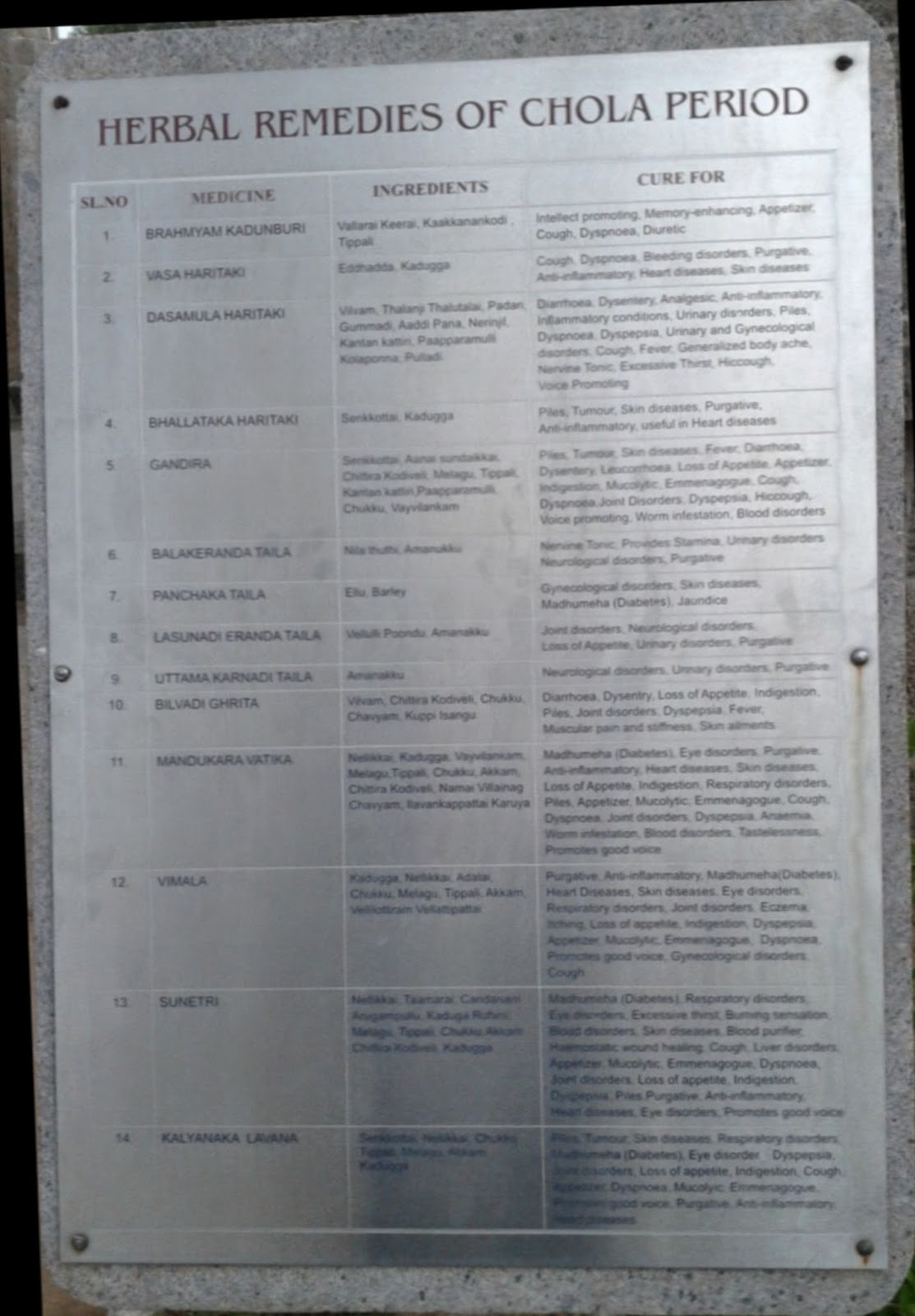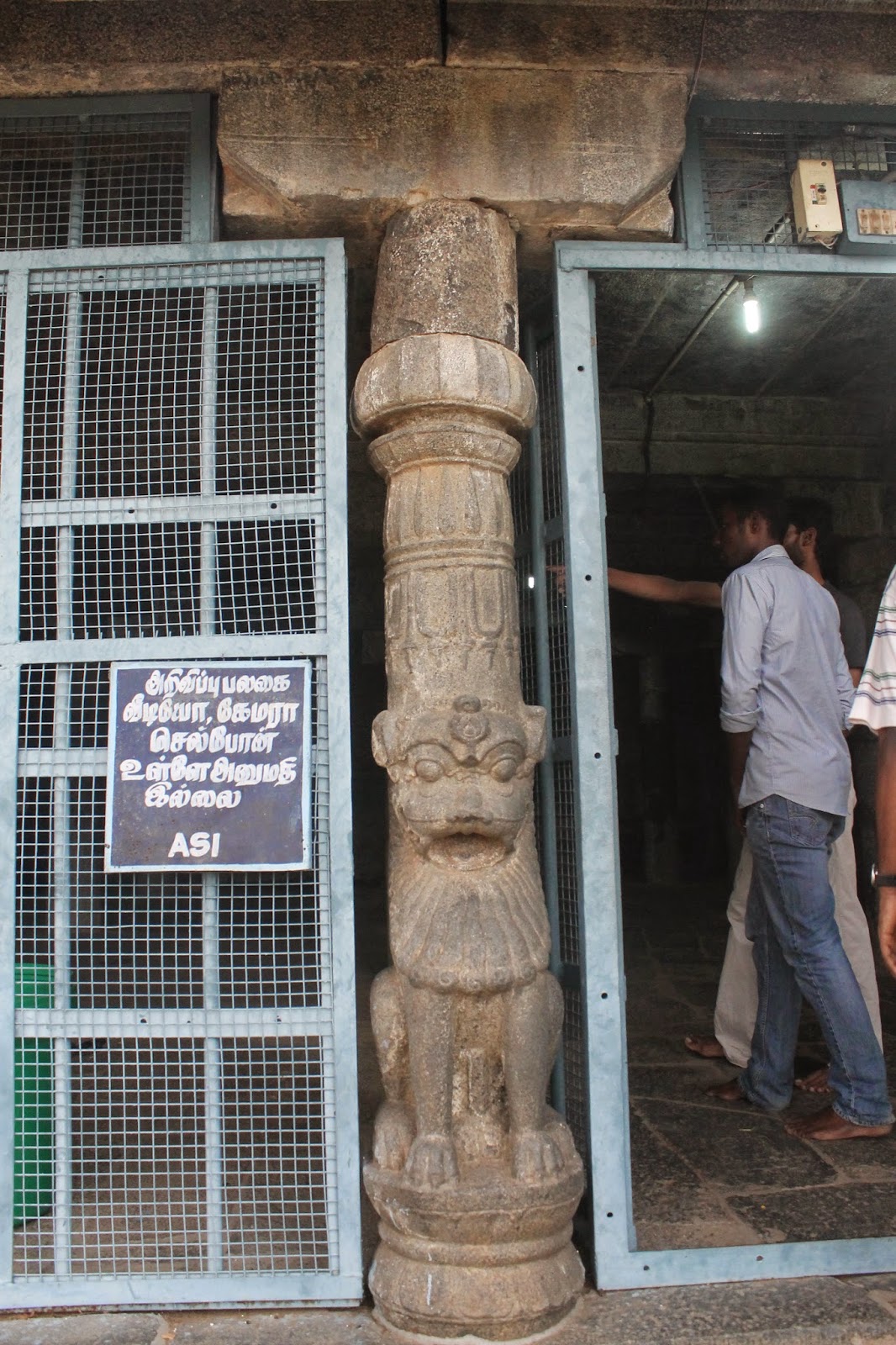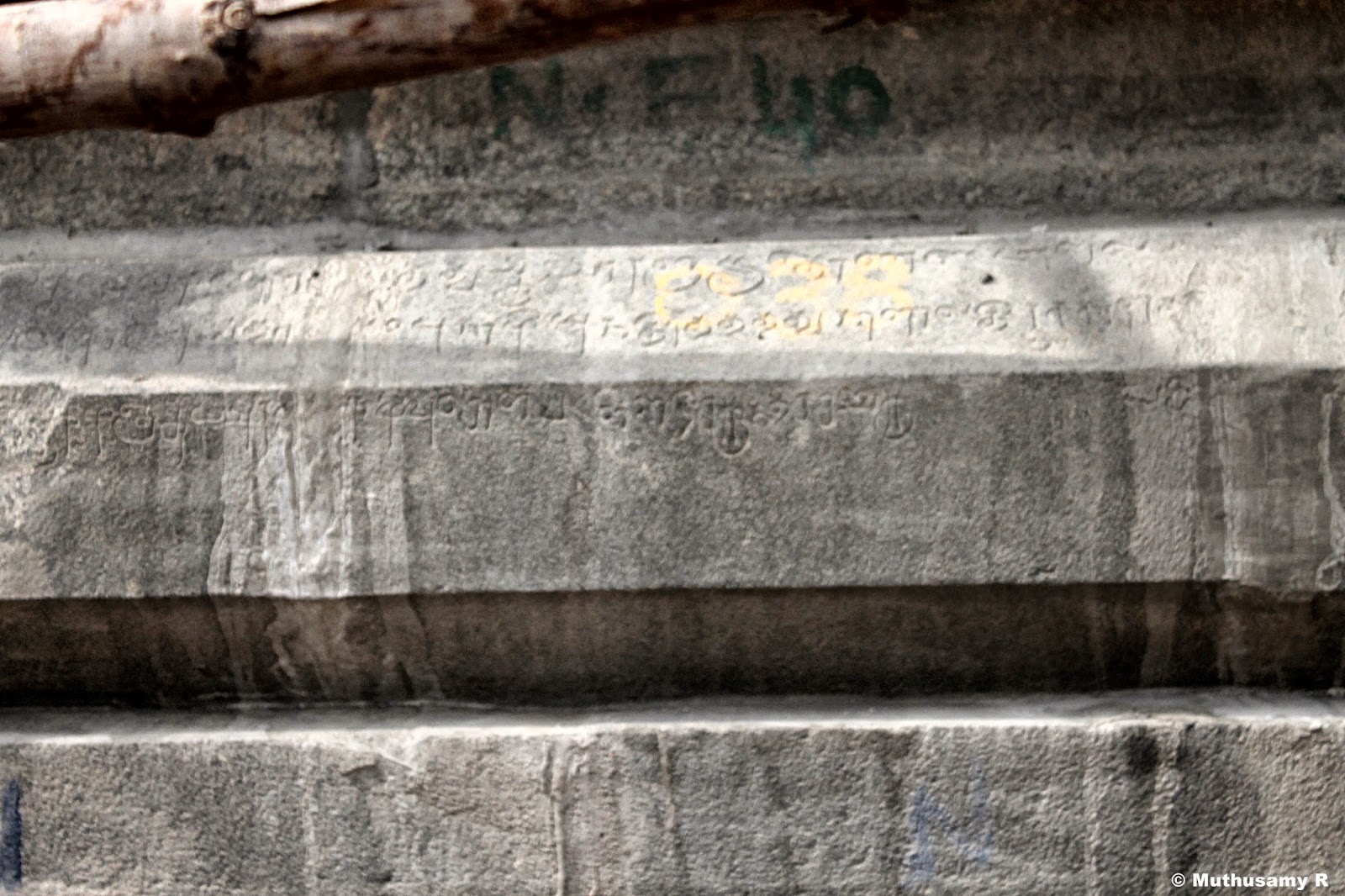 |
| Thirumukkudal Sign-board |
 |
| Venkatesa Perumal Thirumukkudal. Historical Information. Displayed by ASI |
 |
| Thirumukkudal Temple Hospital Stored 20 different drugs (List of Drugs and the relevant data) to treat students, staff and others |
 |
| Thirumukkudal Sri Appan Venkatesa Perumal Temple. Front View 1 |
 |
| Thirumukkudal Sri Appan Venkatesa Perumal Temple. Front View2 |
 |
| 16 Pillar Mandapam: Staircase Parapet showing Yazhi (bas-relief) |
 |
| Rajendra Chola I Meikeerthi (an inscription recording great accomplishments of Emperor Rajendra Chola I) |
 |
| Pallava style Architecture: Seated Lion base pillar / corbels ('potika') and architrave ('valabhi') |
 |
| Visiting Team with Temple (ASI) Staff: Temple staff, Sasi Dharan, ASI Staff, Devenathan Kannan and Raja |
 |
| Thirumukkudal Temple Prakaram - Parivara Deities - Azhwars |
 |
| Thirumukkudal Temple: Pillared Hall and Parvara Deities - Garuda and Karna-Kundala Anjaneya |
Sri Sasi Dharan was explaining about four temples which patronized the study of Veda and Vedanta and conducted Vedic schools during ancient times: 1. Alagiya Narasingaperumal temple, Ennayiram, Villupuram (18 km from Villupuram) (1030 AD), 2. Varadaraja-perumal temple, Tribhuvani (Tribhuvanamadevi Chaturvedimangalam) near Pondichery (1048 AD), 3. Sri Appan Venkatesa Perumal temple, Thirumukkudal near Kanchipuram (1067 AD) and 4. Vedanarayana- perumal temple (Chittirameli Vinnakar) at Anur near Chengalpattu during the reign of Rajaraja Chola I, Rajadhiraja Chola I, Vira Rajendra Chola and Rajarajakesarivarma Pallava. He also briefed about his previous visit to Thirumukkudal temple.
Thirumukkudal (Thirumukkoodal) is quite an interesting and sequestered location and a visit to the Thirumukkudal Temple will catapult you back to the age of the Cholas. En route to Chengalpattu from Kanchipuram Thirumukkudal temple lies on the banks of Palar river. The temple's entrance is from east even though it faces north.
The main attraction of the temple is the imposing six-feet tall stucco image of Sri Appan Venkatesa Perumal, the presiding deity. The Lord faces the north and is in a standing posture. The vimana above the sanctum sanctorum is of Sayana Vimana. The idol is an amalgamation of the Trimurti forms i.e, a manifestation of Shiva, Brahma and Vishnu. The idol appears with crown looking like matted locks of Shiva; the idol also has a third eye on the forehead. The left and right hands of the idol holds Chanka (conch) and Chakra (discus), the weapons of Vishnu. The idol stands on the lotus flower, the symbol of Brahma. Lord is wearing a Salagrama stone garland made of 108 beads. As the deity is the stucco image there is no Thirumanjanam (holy bath) performed but only Thaila Kaapu.
From epigraphs it is learned that the Lord was also invoked with different names such as Vishnu Bhatara (Pallava period); Tirumukkudal-Azhwar and Mahavishnu (Chola period) and Venkateswara swami (later period).
The Lord is accompanied by His consorts, Sridevi and Bhudevi seen meditating at His feet. Markandeya Rishi (Karumanickar) appear seated at the feet and took shelter of the Lord. Lord Venkateswara of Tirumala offered His Conch and Chakra to Raja Tondaiman Chakravarti and saved the king and his kingdom from foreign invasion. Later Tondaiman Chakravarti erected the same Conch and Chakra in the sanctum to glorify the Lord.
There is a separate east facing sanctum for goddess Alamelumanga to the right of the main sanctum. Also there are shrines for Garudazhavar and Anjaneya. The Azhwars, the Vaishnavite saints also appear in the circumambulatory path.
This unusual Pallava style temple built during 9th century A.D. is quite large and appears to have included original plinth (padabandha adhistana) a sanctum (garbhagriha) and eka tala (single tier) vimana and the small pillared porch (ardha mandapa). The vimana is built above a moulded plinth (adhistana) comprising 'upa-peeta,' 'upana', 'Jagati' , tripatta-kumuda' 'kantha' (with 'kampa'). The pada or external walls of the vimana surface have plain 'pathis' or 'bhadras' and there are two central projections and 'koshtas' (niches) at east and west walls, flanked by pilasters. Pilasters support the corbels ('potika') and architrave ('valabhi') above. The prastara or the roof-structure of the sanctum is the very simple form. The oblong shaped single storeyed vimana built with brick.
The pillared hall serving as a portico for one or more small shrines. Six of the pillars found at the pillared hall reminiscent of the distinctive Pallava type with the shafts of the columns supported by the bodies of seated lions. The pillared halls have Mahendra style, cubical top and bottom with intermediate octagonal shaft. The cubical parts of the pillars are adorned with bas-relief images as well as various designs. The pillars and shallow pilasters carry on top massive corbels with beams.
Immense contribution was made by the Chola and Vijayanagara rulers to the architectural expansion of this temple complex. The entire temple complex - several mantapas or pillared halls, bali-peetam and dwajasthambam (flag mast) - are enclosed by the boundary walls. The unfinished east facing main entrance has only the base of gopuram or tower which stands with two huge granite walls (to bear the load distribution) but no towering roof present and therefore known as mottai gopuram. We have noted Vijayanagara style 16 pillared hall with pillars adorned with exquisite bas-relief sculptures depicting the various incarnations of Lord Vishnu, Mahalakshmi, Rama, Garuda, Hanuman and saint Ramanuja.
Festival
The temple festivals: Tamil months Aippasi, Krittigai Deepam, Masi, Janmashtami.
Varadaraja Perumal's Parivettai: Five Perumals - Lord Varadarajaswami of Kanchipuram, Lord Lakshmi Narasimha, Pazhaya Seevaram, Sri Appan Venkatesa Perumal, Thirumukkudal and two other Perumals of near by temples meet together at Thirumukkudal temple courtyard and stay in different mandapas on Mattu Pongal Day - Tamil month 'Thai' (16th January).
Archaeological Survey of India
The temple monument - India’s ancient cultural heritage, is well preserved by the Archaeological Survey of India (ASI). The ASI authorities have preserved the inscriptions without much damage. The maintenance and upkeep of this temple structure are in accordance with the ancient methods of construction technology.
The unique and distinctive inscription (ARE 248/1923) of Vira Rajendra Chola (1063-1068 A.D.), through which this temple became popular. The 55 line inscription documents about the organization and administartion of Veera Cholesvara Aadhular Salai (charitable dispensaries or medical center), to treat students and temple staff, comprising fifteen beds under the charge of a physician. Ancient physicians stacked away 14 other medicines to cure various ailments, including fever, urinary disorders, hemorrhage, lung diseases, fatigue, mental disorders, jaundice and eye and skin diseases. With the help of experts from the National Institute of Siddha and Central Siddha Research Institute, the ASI maintains the herbal garden and grow medicinal plants on the temple grounds. NISCSRI and ASI are together plan for an expansion programme is likely to cover nearly an acre in the coming months.
Inscriptions
The plinth (jagadi, tripatta-kumuda, walls, pillars, pilasters of the main sanctum as well as those of second cicumambulatory path (prakara), the north facing wall at the pillared hall and the east facing outer wall are dotted with 17 inscriptions in Chola Tamil script and most of them speaks about the land endowments for burning perpetual lamp in the temple and for offering to the deity and for flower garden in the name of Rajendra Cholan I, devotees offered sheep, paddy in specific grain measurement and gold. The inscriptions also details the offerings made to the deity three times a day, like kumkum, camphor, sandal paste and lamp as well as for specific offers for festivals / celebrations during Tamil months Aippasi, Krittigai, Masi and Janmashtami (Lord Krishna's birthday) and King's birthday. Provision was made for the recitation of Nammazhwar's `Tiruvoimozhi.'
The earliest inscription in the temple was recorded in the 24th year of Vijaya Nripatungavarman, the Pallava ruler. According to the Pallava inscriptions, Thirumukkudal was located in the assembly of Siyapuram in Urrukkattuk-kottam in Jayangondasola-mandalam.
South Indian Inscriptions. Volume 12. Stones No.75 (A. R. No. 179 of 1915). Tirumukkudal, Conjeeveram Taluk, Chingleput District. On a slab supporting a beam set up in the inner enclosure of the Venkatesa-Perumal temple.
This record states that, in the 24th year of Vijaya-Nripatungavikramavarman, the assembly of Siyapuram in Urrukkattuk-kottam agreed to maintain a perpetual lamp in the temple of Vishnu-Bhatara at Tirumukkudal for the interest on 30 kalanju of gold received by them from Ariganda-Perumanar, son of Kadupatti-Muttaraiyar. The interest on 30 kalanju came to 4½ kalanju, calculating at the rate of 3 manjadi per kalanju. For this 4½ kalanju, the assembly of Siyapuram agreed to supply oil at a uniform rate of 40 nali per kalanju for maintaining the lamp. Palaiyasivaram near Tirumukkudal is called Siyapuram in inscriptions.
கோவிசய நிருபதுங்க பல்லவ விக்கிரம வருமக்கு யாண்டு இருபத்து நாலாவது காடுபட்டிமுத்தரையர் மகனார் அரிகண்டப்பெருமானாருக்கு ஊற்றுக்காட்டுக்கோட்டத்து சீயபுரத்து சபையோமொட்டிக்கொடுத்த பரிசாவது திருமுக்குடல் விஷ்ணுபடாரர்க்கு நுந்தாவிளக்கெரிப்பதற்க்கு தந்த எங்கள் கையிற்றந்த முப்பதின் களஞ்சு நாலுப் பொலியூட்டு ஆண்டுவரை களஞ்சின் வாய் மூன்று மஞ்சாடிபொன் ஆயனப்படியால் நாற்களஞ்சரையாலும் ஏறிலும் கறுங்காலும் நாற்பது நாழி எண்ணை நூற்றின்பதி ....
The Chola inscriptions included Tirumukkudal in the ancient territorial sub-division known as Madhurantaka-Chaturvedimangalam, which was a part of Kalatur-kottam, a district of Jayamkonda-sola-mandalam.
Timings
The temple is open between 08.30 am to 11.30 am and 4 pm to 6 pm on weekdays. On Saturdays and Sundays the temple is open from 08.30 am till 1 pm and from 3 pm till 7 pm.
Contacts: The temple priest Sri Raghunaadhan (Tel: 94437 78352)
How to Get There
Sri Appan Venkatesa Perumal Temple, Thirumukkudal Kanchipuram District. Tamil Nadu, India. Pin code is 603106 ( Orakattupettai ).
Geographical Location: at latitude 12 ° 45′0'' and longitude 12 ° 45′0''
Nearest Railway station: Palayasivaram and Palur stations, on the Chennai - Chengalpattu - Kanchipuram line. Can be reached via Chengalpattu.
Nearest Airport Meenambakkam Airport in Chennai.
Temple lies on the south bank of the river Palar. It is 16 Km away from Chengalpattu City and well connected by a good network of roads. There are frequent bus services from Chennai to Chengalpattu,Kanchipuram and other places.
Reference
- Field trip of second batch of epigraphy students to Thirumukoodal. Reach Foundation. March 12, 2010. http://reachhistory.blogspot.com/2010/03/field-trip-of-second-batch-of-epigraphy.html
- In typical Pallava style by Chitra Madhavan. The Hindu Feb 04, 2005.
- Treatment of the mentally ill in the Chola Empire in 11th -12th centuries AD: A study of epigraphs by Vijaya Raghavan. D, Tejus Murthy. A. G, and Somasundaram, O. Indian Journal of Psychiatry. 2014 Apr-Jun; 56(2): 202–204.
- Medicinal plants to grow again at ancient temple Julie Mariappan http://epaper.timesofindia.com/Default/Layout/Includes/TOINEW/ArtWin.asp
- Reminiscing the Chola legacy Chitra Madhavan Indian Express Jan 29, 2014
- South Indian Inscriptions. Volume 12. Stones No.75 (A. R. No. 179 of 1915). Tirumukkudal, Conjeeveram Taluk, Chingleput District. On a slab supporting a beam set up in the inner enclosure of the Venkatesa-Perumal temple. http://www.whatisindia.com/inscriptions/south_indian_inscriptions/volume_12/stones_51_to_75.html
- Thirumukkoodal Sri Appan Prasanna Venkatesa Perumaal. In Dhivya Dharsanam. Tuesday, May 24, 2011 http://www.dharsanam.com/2011/05/thirumukkoodal-sri-appan-prasanna.html
- Worship of Lord Brahma, Part 61
- ஆயிரம் வருட பழமையான கல்லூரி by Sasi Dharan March 4, 2013 https://www.facebook.com/SasidharanGS?hc_location=timeline
- வரலாற்று வரைவுகள் இரா. கலைக்கோவன் http://www.varalaaru.com/design/article.aspx?ArticleID=359
Youtube
Thirumukkudal.mp4 by Saravanan Iyer
Appan Venkatesa Perumal Thirumukkudal 16.1.13





















